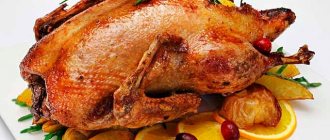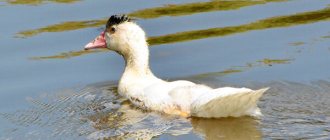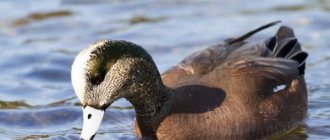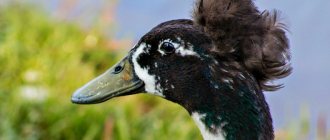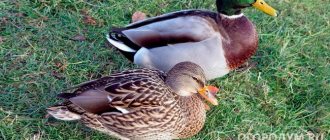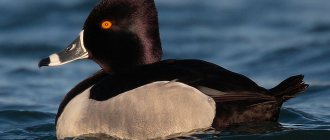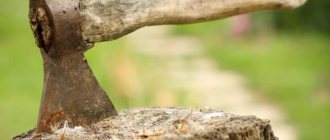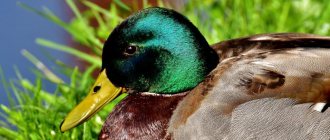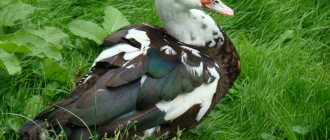It seems that there is no task as simple as distinguishing a drake from a duck among Indian ducks, but in fact, only adult birds are noticeably different. At the same time, novice farmers buy small ducklings or hatching eggs, and it is difficult to distinguish the young animals by sex. However, this is important, because the living conditions for ducks and drakes are slightly different, and balance in the flock must be maintained: an excessive number of females or males will lead to a decrease in the productivity of the birds.
What is the difference between an Indian duck and a regular duck?
224
no comments yet
Author of the article
Novikov Kirill
Reading time: 6 minutes
Indoutka (muscovy duck) is one of the most popular types of ducks among poultry farmers. This is due to the fact that Indian ducks, combining the properties of geese and ducks, have good egg production and tasty meat. Externally, this species is distinguished by a bright red growth around the beak, from which fat is secreted that smells of musk.
Mulard is an interspecific hybrid created on the basis of the Muscovy duck and several other species of domestic duck (Orpington, Peking white, Rouen). This breed belongs to the meat breed of productivity, and is also valued for its fatty liver. Unlike Indian ducks, mulards do not produce offspring, although they can lay eggs.
Description
Wild Indian ducks are dark in color with a few white feathers. Domestic breeds can have different colors.
- Black Indian ducks have a completely black color, the back and wings have a green tint, the rest of the body is purple. The down is dark gray, the beak and paws are black, and the eyes are brown.
- The brown duck has chocolate brown plumage. In this case, there may be individual white spots on the body, the wings and neck may have a dark, almost black, tint.
- Walnut-colored Indian ducks differ from the previous variety by having lighter colored plumage. It may have white spots and darker feathers on the tips of the wings and on the neck.
- Bluebirds have a pronounced blue color throughout the body, but individual feathers stand out with their dark edging. Beak and paws are black
- White Indian ducks have snow-white plumage, without a hint of yellow. The beak is pale pink, the legs are yellow. The eyes are gray with a blue tint.
- White with a black spot on the head - they differ from the previous variety only in the presence of a spot.
A distinctive feature of the Muscovy duck's appearance is the fleshy growths on its head, which are also called corals and warts. They are located above the beak and in the eye area.
Because of these growths, some believe that turkey ducks were the result of crossing ducks with turkeys, but this is not so - these two varieties of birds cannot give birth.
The Muscovy duck lays from 8 to 14 eggs, which it incubates for 35 days. Ducklings of this breed can have different colors - they are yellow, yellow with black spots, black with yellow spots. The beak color of small Indian ducks ranges from pink to dark, almost black.
This is a meat breed, that is, one of the broiler breeds. Domestic Indian ducks are much larger than wild ones: males reach a weight of 6 kg, females - 3 kg.
Comparative characteristics of meat and eggs of turkey and mulard
| Products | Indian | Mulard |
| Meat volume as a percentage of slaughter weight | 50% | 70% |
| Taste and texture of meat | Tender meat with dense fibers and a small layer of fat, tastes like game; has a pronounced aroma | Tender meat, tastes like beef; no specific odor |
| Fat content of meat | Moderately fatty | Dietary |
| Useful properties of meat | High content of protein, unsaturated fatty acids, minerals (potassium, calcium, etc.), vitamins B, A, C, E, D, K | Low cholesterol, high protein, minerals (potassium, calcium, etc.), omega-3, vitamins A and B |
| Possible harm to meat | Not recommended for use by people with obesity, diseases of the gastrointestinal tract and kidneys; persons with high cholesterol levels in the blood | Not recommended for use by people with obesity, diseases of the gastrointestinal tract and kidneys |
| Egg production | Up to 120 eggs per season | — |
| Egg weight | 80 g | — |
| Useful properties of eggs | High content of calcium, phosphorus, magnesium; increased nutritional value | — |
| Possible harm | Possible allergic reaction; should not be used by children, pregnant women and people suffering from chronic pathologies of the gastrointestinal tract and liver | — |
What is the difference between Indo ducks, Muscovy ducks and regular ducks?
The Turkey duck, which is popularly called the Muscovy duck, contrary to popular belief, is not a hybrid of a duck and a turkey. The bird belongs to the arboreal species, which distinguishes it from the standard representatives of the group, most of which are waterfowl. The name "Indian duck" is an abbreviation of the phrase "Indian duck." This is due to the fact that Indian tribes were actively involved in breeding mallard ducks.
It grows wild in South America and Mexico. These animals differ from the ordinary duck in the following ways:
- the body is elongated, wide, the head is elongated, the neck is short;
- there are red skin growths on the front part;
- there is a crest on the head (it rises when frightened);
- specific gait - when moving, the mallard shakes its head back and forth.
By crossing female common ducks with Indo-duck drakes, a hybrid duckling can be obtained. Such offspring are called mulards. The similarities between musk ducks and mullards are very great.
Expert opinion
Zarechny Maxim Valerievich
Agronomist with 12 years of experience. Our best country expert.
Ask a Question
Birds also differ in character: musk ducks have a calm disposition, easily make contact, and do not scream, while ordinary mallards make a lot of noise when frightened.
Definition
The duck is a common bird, of which there are quite a few species in nature. Some breeds are successfully raised by people. The duck is a medium-sized bird. It has an elongated, non-sharp beak and a somewhat elongated neck. The color of the plumage is very diverse. The male of this bird is a drake.
Duck
Indo-duck is popularly called the Muscovy duck. In the wild, the bird lives in large numbers in South America and Mexico. There it was domesticated by humans. Gradually, the musk duck was brought for breeding to other parts of the Earth.
Indian
Productive qualities: which bird to choose
When raising ducks for meat, preference is often given to mulards, since these birds have a number of advantages:
- a large mass that an individual gains in a short period of time. Poultry farmers note that mulards fatten faster than geese and other domestic ducks;
- tender meat with low fat content;
- large liver in males - is a delicacy, used for foie gras.
It should be taken into account that breeding mulards at home naturally is impossible, and the cost of the hybrid is higher than other meat-producing ducks.
Which bird do you prefer for breeding and raising at home?
MulardamIndoutkam
Indo-ducks, on the contrary, can be bred independently; they do not require special housing conditions and can do without a pond. This species is characterized by high survival rate and unpretentiousness in food. In addition to meat, you can also use turkey eggs for food, the beneficial properties of which are not inferior to chicken eggs. These advantages, combined with the high proportion of useful substances contained in the products, make musk ducks not only attractive to poultry farmers, but also more in demand than mulards.
Sex differences
In adults, sex differences are easier to detect than in chicks. To determine the sex of a domestic turkey, you need to find the cloaca located under the bird’s tail and move it slightly apart with massaging movements. Males will develop a pseudopenis at this location. In small male birds, the organ is poorly expressed, only a few mm long. It is difficult to determine the gender of young animals in this way; only experienced livestock specialists can do it.
Read also: Making a drinking bowl for broilers with your own hands
The sex of hatched chicks can be determined by examining the cloaca after the first 24 hours of life. The main thing in this matter is precise movements that will allow you to detect the characteristic tubercle.
Aggressiveness of male representatives in a pack is a common occurrence. Males try to demonstrate leadership qualities as early as two weeks of age. They attack not only other drakes, but also birds nearby. At the same time, males treat females with care, often letting girls go first. Drakes show increased care during the egg-laying period.
A duck only shows aggression if it believes its brood is in danger. In general, females are calm and peaceful. They will not get into a fight with their relatives or other inhabitants of the poultry yard.
Before sitting on the eggs, the duck covers the nest. The drake is nearby at this time, monitoring the surrounding situation. He will protect the hen during the entire period of incubation of eggs. When ducks hatch eggs, drakes become calmer. They move in small groups, alternately passing each other forward, not far from the poultry house.
Farmers of Russia
Many rural residents, in addition to chickens, geese and ducks, also breed indo-ducks (muscovy ducks). They usually live in the tropics and live in trees. But it’s not difficult to breed Indian ducks at home. They are usually kept in several families in which there are at least two females. The weight of a male is approximately 6-7 kg, and a female is 2-3 kg.
Typically, the female lays up to one hundred large eggs, 75 g each, over the course of a year. The meat of ducks is very tasty, tender, low-fat, and is considered dietary. Muscovy ducks are unpretentious in their diet; they eat everything. They are usually fed wet mixed food.
They readily eat chopped grass, beets, grain and corn. If you give them barley, then only pre-soak it in water.
Indian ducks eat less than regular ducks. If there is a lake or river nearby, this makes feeding much easier. Earthworms and insects are their favorite delicacies.
It would be nice to dig a pond especially for them. However, it is important to know that musk ducks attack anything shiny (glass, metal, nails), which they immediately swallow.
Therefore, there should be no such objects in their habitats. Perches can be built by simply placing logs for the ducks to sit on.
It would be a good idea to cover them with forest pine needles for softness. The only problem is that Muscovy ducks do not like to live together with other birds, so it is better to fence them off from everyone else. Indo-duck meat is juicy, tender, lean, with a gamey flavor, has a reddish tint and is very rich in protein. Muscovy ducks hatch eggs very well, however, ducklings hatch remarkably well in an incubator.
They usually begin laying eggs in March or April. When a duck lays up to 20 eggs, it sits on the nest. It is very important to put a date mark on the egg shell every day, this is necessary so that the eggs do not overstay.
The chicks hatch from eggs that have been in the nest for 16-19 days. Before hatching eggs, it is necessary to prepare a nest for the indot duck in advance. To do this, take thick fabric, preferably burlap, and place it on the bottom of the nest, and the nests themselves are separated from each other by pieces of cardboard. It is necessary to place water near the nest so that the duck can get up to bathe and drink.
She bathes to wash off fleas and parasites. One more point: it is very important that no other chicks fly into the duck’s nest, otherwise she will forget about her eggs and begin to nurse other people’s chicks. The chicks usually hatch within a month.
They are not able to drink and feed themselves. To teach them this, you need to boil eggs, chop them and sprinkle them on the ducklings so that they peck at each other.
Benefits of Muscovy Ducks
- They tolerate cold weather well; their room does not need to be heated. The main thing is that in cold weather the floor is not wet, and they can freely approach the water.
- For musk ducks, the presence of a pond is not necessary.
- They are very resistant to viral diseases.
- Among the Indian ducks, one can clearly distinguish a female from a male, since she is half his size. However, like everyone else, they have minor drawbacks. The long incubation period is 33-36 days, unlike chickens and the period of growing for consumption is 12-13 weeks.
Behavior
If the flock is in danger, in addition to loud hissing, the aggressive male may ruffle his crest. Females never do this.
Aggressiveness of male representatives in a pack is a common occurrence. Males try to demonstrate leadership qualities as early as two weeks of age. They attack not only other drakes, but also birds nearby. At the same time, males treat females with care, often letting girls go first. Drakes show increased care during the egg-laying period.
A duck only shows aggression if it believes its brood is in danger. In general, females are calm and peaceful. They will not get into a fight with their relatives or other inhabitants of the poultry yard.
Before sitting on the eggs, the duck covers the nest. The drake is nearby at this time, monitoring the surrounding situation. He will protect the hen during the entire period of incubation of eggs. When ducks hatch eggs, drakes become calmer. They move in small groups, alternately passing each other forward, not far from the poultry house.
Comparison
One of the characteristics that distinguishes a duck from an indo-duck is the appearance of these birds. The Indian duck looks more distinctive. In its appearance, red growths stand out against the background of the general color. They are located at the base of the beak and cover the area around the eyes. These formations suggest that the bird is the result of crossing a turkey and a common duck, hence the name turkey. But it must be said that such guesses are completely unfounded. The Muscovy duck is in no way related to the turkey and is a separate species.
Why didn’t people in countries far from America limit themselves to breeding ordinary ducks? Why did they fall in love with the foreign guest so much? First of all, the fact that turkey meat has special qualities. Compared to regular duck meat, it is more tender, without a specific taste and cooks faster. Indo-duck is a source of lean meat that belongs to the category of dietary products. In addition, the bird lays eggs well, and its eggs with a large yolk surrounded by dense white are quite suitable for consumption. However, the eggs of a common duck are often inedible due to their not very pleasant taste.
What is the difference between a duck and an indo-duck regarding the degree of difficulty in breeding them? Those who have kept such a farm claim that it is easier to cope with an indo-duck. After all, the presence of a reservoir is not at all necessary for it. The bird is relatively unpretentious and is resistant to infections. Unlike its relatives, who quack loudly, the Indian duck does not create noise. It mostly produces only hissing sounds. The bird is peaceful, prefers not to move away from the yard and watches over its ducklings. True, it grows a little slower than other ducks, but it can reach larger sizes.
Sex determination in young animals
When the ducklings have just hatched, it is almost impossible to distinguish a duck from a drake, especially for an inexperienced person. But there are tricks that will help you understand whether the person in front of you is a boy or a girl.
Thus, from birth, male Indian ducks have a rudimentary organ called a pseudopenis. Finding it is difficult, but possible.
Take the duckling and place it in your palm with its beak facing you. The skin of the cloaca needs to be slightly stretched. On the drake you will notice a spiral-like appendage. It is tiny, only 0.5-2 mm, but females do not have this. They only have small spherical growths.
For an inexperienced farmer, this method of distinguishing a male from a female is not easy, but it is 100% accurate.
A less accurate but acceptable option is to simply inspect the ducklings. Boys' down is darker. This is especially noticeable if birds of different sexes are together.
Keeping Muscovy Ducks
In a herd there are four females for every male. It is beneficial to have several families.
When breeding musk ducks, three individuals should have 1 m2 of house area. Muscovy ducks do not tolerate the proximity of other bird species.
Wood ducks prefer logs for roosting.
Considering the southern origin of the birds, it is necessary to provide them with warmth. The temperature in the poultry house should not fall below 15 degrees Celsius. And for ducklings the lower limit is 20 degrees Celsius.
Culinary secrets
From the chef's point of view, there is no big difference between musky and regular duck - they are prepared approximately the same. But we still decided to dwell on the main features of roasting a whole turkey so that our readers can count on the best possible result.
- The meat of fresh or chilled poultry is juicier than frozen poultry, since it loses a lot of liquid during defrosting. In order to minimize moisture loss, the bird must be given the opportunity to thaw gradually in the main chamber of the refrigerator, so it is recommended to remove the turkey from the freezer a day before cooking.
- Before cooking, the duck should be inspected, any remaining feathers and entrails removed, if any, then washed and dried with paper towels.
- It is recommended to marinate the whole bird before roasting. For Indian duck, a dry marinade is often used, rubbing it with a mixture of salt and seasonings. Additionally, you can use vegetable oil, sour cream, mayonnaise, mustard, soy sauce, balsamic vinegar, lemon or orange juice. These products soften the meat fibers, but do it delicately, so that when roasted the bird becomes soft and tender, but does not acquire a sharp taste.
- The baking time for turkey depends on its weight. For each kilogram you need to take 45-50 minutes and add 20-30 minutes for frying. Muscovy duck, weighing 2-2.5 kg, is baked for 2 hours or a little more. The temperature in the oven at this time should be 180-200 degrees, but at the beginning or end of cooking it can be increased to 220-230 degrees to form a crispy crust.
- To prevent the bird from drying out during long-term heat treatment, it is recommended to bake it in foil or a culinary sleeve, but 20-30 minutes before the dish is ready, they must be cut so that the duck is browned.
Indoutka is often baked with a filling of apples, oranges and other fruits, less often - with minced cereals, mushrooms, and vegetables. At the same time, you can bake potatoes or other vegetables, buckwheat or rice. They are served with Indian duck as a side dish. It is recommended to serve sauces with musky duck. Gravy with a sweet and sour taste is best suited to it.
We have already told you how to roast a whole ordinary duck.
Mulardy ducks
are an interspecific hybrid obtained by crossing musk drakes and domestic ducks, in particular with the Peking duck.
This type of duck is excellent for home breeding and industrial fattening. They are simply ideal for industrial fattening, since the liver of this duck, like the liver of a goose, can be used for such unique food as Foie gras.
Mulard meat can be compared in its characteristics to goose meat, which takes much more time to fatten.
Mulards are unpretentious in food and can gain weight well even on grass, which they eat just like geese, without special “duck” food.
They gain weight a little longer than Peking ducks and reach four kilograms in three months.
The main positive characteristics of Mulardy ducks:
- cleanliness
- calm character
- precocity
- large live weight
- quality meat
Mulards are sterile, have good health and adapt well to environmental conditions. They can be released into the pond at the age of one month. It is impossible to meet them in the wild, as they are an artificially bred breed.
This breed of duck is ideal for those people who do not welcome fatty poultry meat. Mulard's fat content can be as low as 3%.
Other characteristics of the meat of such a duck can easily be compared with goose meat, however, the fattening time of geese can be up to 8 months, and the fattening period of such a duck is only 4 months.
This breed of bird is considered incredibly clean, silent and quiet, which in our opinion is very important!
Disadvantages of Mulardy breed ducks: with such qualities, I would like more mass of the duck. (5-6 kilograms). We have a separate article about this wonderful breed of ducks in detail.
What are the differences between bird species?
Frankly speaking, if you are cooking for yourself, your family and friends, and not for serving in a Michelin-starred restaurant, you will not feel much difference. Both ducks will turn out tasty, juicy and with a crispy crust. Neither indouct nor mulard will disappoint you if you cook the bird according to all the rules. But if you are very meticulous about cooking, and can lecture for hours on the topic of cooking poultry, then you will notice the difference in taste.
Turkey meat is considered more valuable due to the fact that it contains less fat. But be that as it may, both turkey and mulard are dietary meats that taste a little like broiler meat. Farmers, on the one hand, love mulards because the young bird grows quickly and gains weight, on average, 3.5-4 kg. But on the other hand, this type of duck does not reproduce naturally, so Mulards are bred by farmers who are ready for additional troubles.
Breeding at home
The Muscovy duck is an unpretentious bird, but the main nuances of feeding and required care must be taken into account.
Nutrition
An economical solution to this issue is to use feed mixtures, which allows grain crops (45%) to enter the mute mule’s body unchanged, and add greens, root crops, and vegetables to the rest. Whole grains are used for food only in the evening, and the wet mash is given in such a volume that pets can eat in 45 minutes due to possible souring in summer or freezing in winter. Complexes of vitamins and minerals, as well as table salt, are added to the food.
Young animals are fed with special attention, because the first days of life form the immunity of individuals. Therefore, an egg is gradually introduced into the food, then fermented milk products, and from the 10th day, potatoes are boiled, and protein food is given in the form of meat and bone meal or minced meat. To prevent small birds from rickets, it is necessary to add vitamin mixtures or premixes, which can be purchased at veterinary pharmacies. Change the water frequently, pouring clean water at room temperature.
Chopped corn kernels are considered the favorite delicacy of mute mules. Adults should receive fresh cabbage leaves, flaxseed cake, legumes, beet tops and kitchen waste in their diet. Do not overuse bread and potatoes, the norm of which is up to 20% of the total feed.
The following main care requirements can be identified:
- Cleanliness of the room. Ducks trample heavily on the flooring in the poultry house, causing everything in it to get mixed up. If there is food on top, and droppings get inside the body along with it, this can be fraught with disease. Therefore, the poultry house is cleaned every 2-3 days. At the walking area, be sure to remove all shiny elements and nails so that curious birds do not swallow them. There they will also equip a “pool” for swimming, using a large container of water.
- Vaccination. The immunity of musk ducks is quite strong, but it is better to prevent them from viral hepatitis by getting vaccinated at the age of 3-4 weeks and again after 2-3 weeks.
- Water and feed must be changed promptly. Inspect birds regularly to watch for diseases and take isolation and treatment measures quickly.
